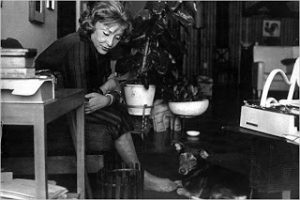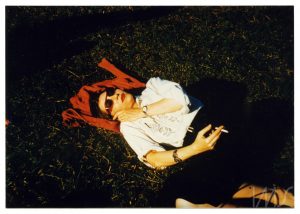IMS, Equipe. Ulisses Lispector: A Portrait. IMS Clarice Lispector, 2023. Disponível em: https://site.claricelispector.ims.com.br/en/2023/04/26/ulisses-lispector-a-portrait/. Acesso em: 13 December 2025.
The film portrays the famous Ulisses, Clarice Lispector’s dog and a prominent character in her life and fiction.
He is present in the posthumous novel A Breath of Life, he is the narrator of the children’s book Quase de verdade (Almost True), he was mentioned in countless chronicles, and today he is immortalized, alongside his owner, in a bronze statue at Leme Beach, in Rio de Janeiro.
Ulisses was also photographed smoking cigarette butts during Clarice’s interview with the weekly O Pasquim, whose behind-the-scenes is told in detail by the editor Sérgio Augusto, who at the time participated in the meeting, which took place at the writer’s apartment.
About the main character, other themes are also addressed, such as Clarice’s intimate relationship with the irrational nature of animals and autofictional writing, as well as an analysis by the writer Evando Nascimento of the short story “The Crime of the Mathematics Teacher.”
See also
 by Bruno Cosentino
by Bruno Cosentino
Caetano Veloso says that when he showed the acoustic version of his song “Odeio” (I hate), which would be included on the Cê album, to his friend and composer Jorge Mautner, the latter cried and told him that it was the most beautiful love song that he had ever heard.
 by Bruno Cosentino
by Bruno Cosentino
For the journalist Laura Freitas, Clarice’s female characters hide the germ of nonconformity – “the women are wild,” she affirms.
 by Elizama Almeida
by Elizama Almeida
Ulysses was Clarice Lispector’s last dog, a mongrel who stole cigarette butts and queued for Coca-Cola and whiskey for visitors. He was so eccentric that he earned a robust note in the infamous periodical O Pasquim.
 by Elizama Almeida
by Elizama Almeida
Written in the 1950s, during the period in which she lived in Washington, The Mystery of the Thinking Rabbit was the first children’s book written by Clarice Lispector.
 by Bruno Cosentino
by Bruno Cosentino
Academic studies on Clarice Lispector continue to be developed at foreign universities. In 2017, a wide-ranging seminar about the author was held at the University of Oxford.
 by Lilian Hack
by Lilian Hack
That was the first sensation which I had when I saw Clarice’s paintings: my whole body shivered in a flush that was shared with these two women who worked every day at the archive. A kind of slip, a discomposure, a “human dismantling.” As Clarice wrote, “She needs to move her whole boneless head to look at an object.”






